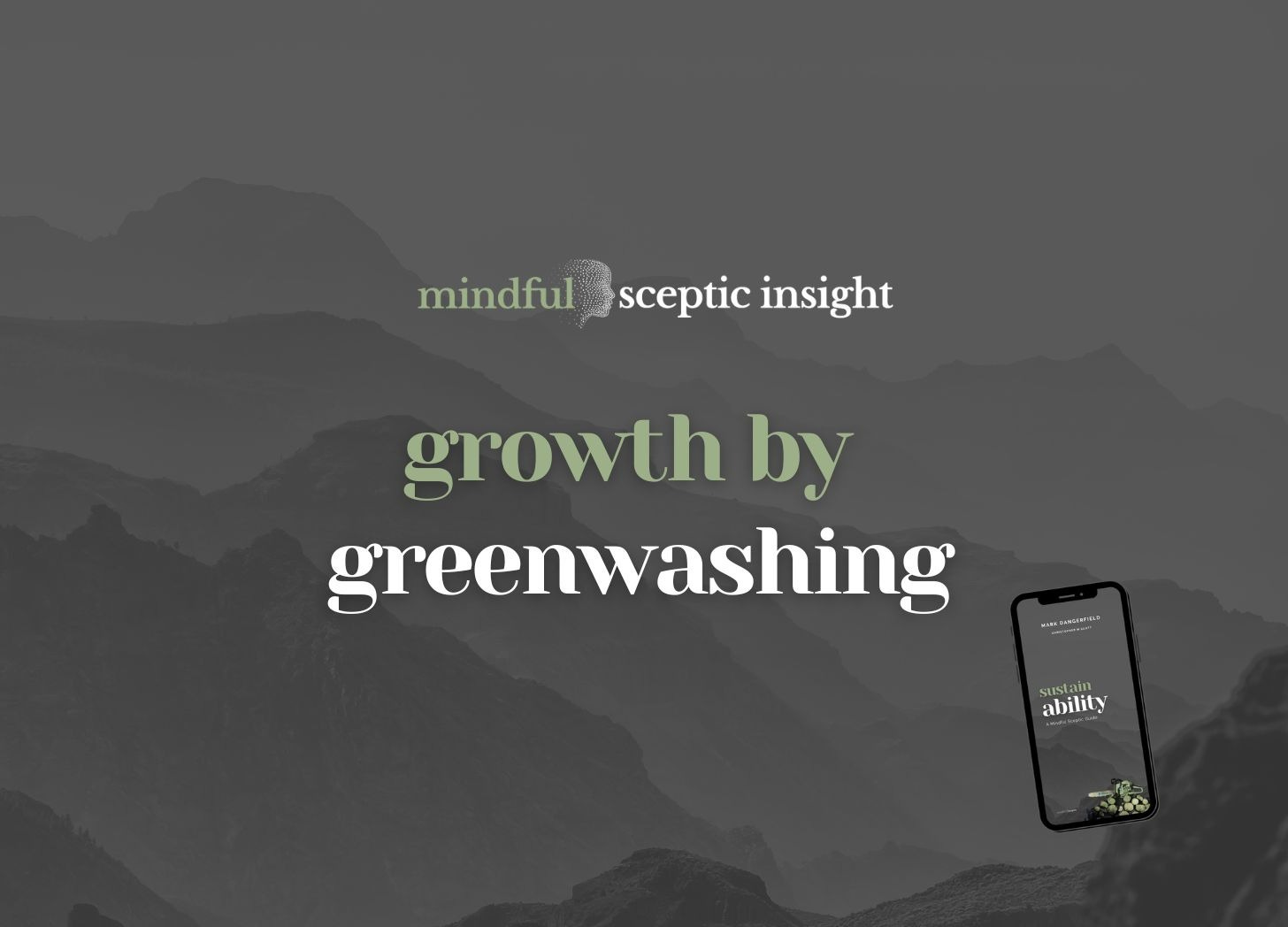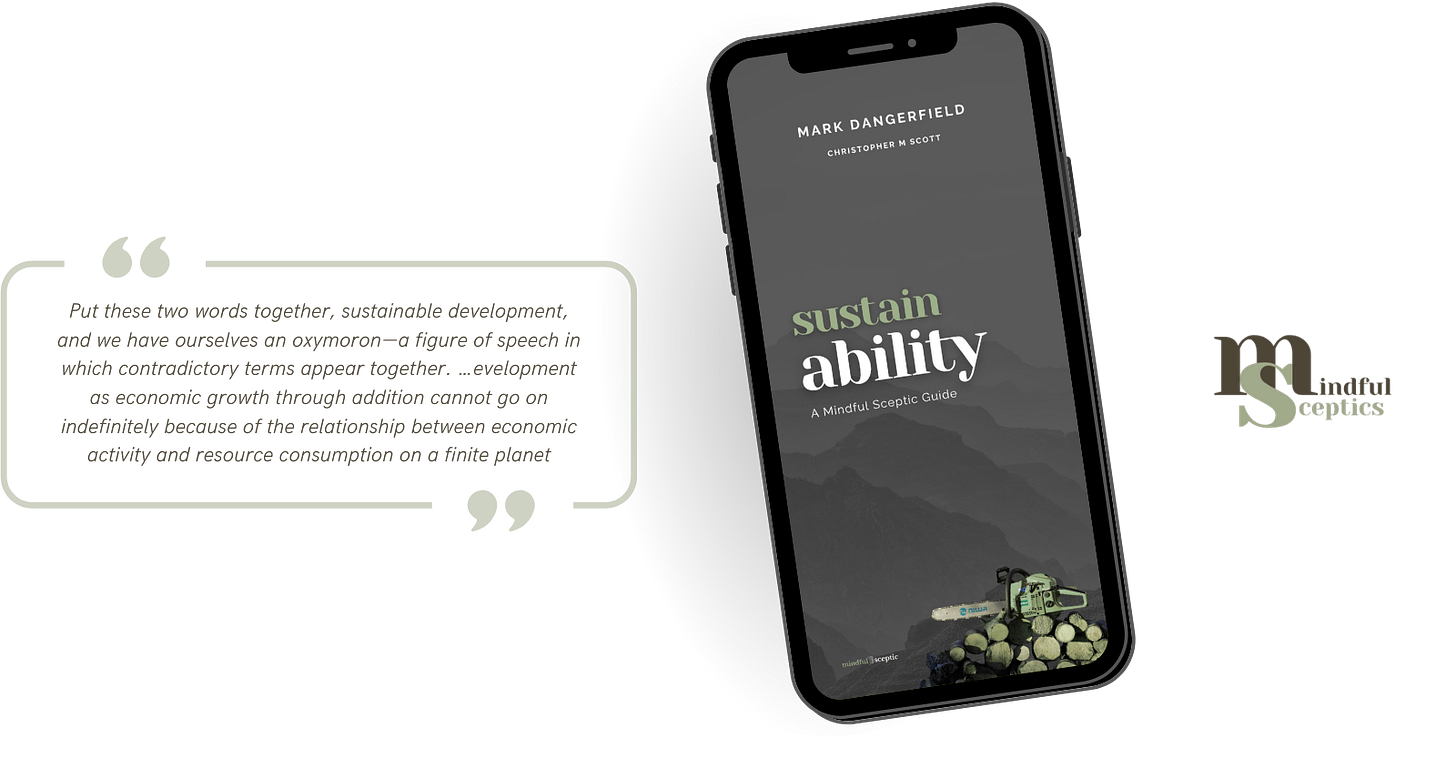Core Idea
By combining ‘sustainable’ with ‘development’, the United Nations has given us a delightful linguistic contradiction.
Development, by definition, means growth, progress, positive change, or the addition of physical, economic, environmental, social and demographic components. Sustainable means maintaining a certain rate or level, keeping things going without interruption.
Only the mathematics are simple… development as economic growth through addition cannot continue indefinitely on a finite planet.
Put these two words together and you create an oxymoron.
So why is the phrase so pervasive?
The synonyms tell the story. Sustainability offers stamina, resilience, stability, and equilibrium, while development delivers advancement, betterment, improvement, enhancement, and flourishing.
Getting better and doing better runs in our genes. It drives us to take risks, make more, and become more. And we are so extraordinarily good at making more that we ignore what we know about nature and the finite dimensions of this tiny blue planet.
So instead of accepting the biophysical realities, we fall in love with this phrase because it promises endless betterment without consequences. In short, everything we want.
Counterpoint
The UN’s 2030 Agenda for Sustainable Development presents itself as a shared blueprint for peace and prosperity for people and the planet, now and into the future.
The 17 Sustainable Development Goals promise to end poverty through strategies that improve health and education, tackle climate change, and preserve oceans and forests. All simultaneously. All without limits. The SDGs assume the current economic model is the only path out of poverty, ignoring that most wealth begins with nature’s services.
Every human needs 2,500 kilocalories of food daily, somewhere to live, and resources to make a living. Multiply that by 8 billion people, and the thermodynamic reality becomes unavoidable.
The Great Acceleration of the past 150 years delivered a spectacular spike in population, resource use, and environmental impact, enabled by a one-time pulse of ancient energy stored in fossil fuels. We converted this energy bounty into more humans.
Unpacking the Great Acceleration
Everywhere on Become a Mindful Sceptic you will see references to the recent surge in human numbers, activities and impact on nature. It is time to take a closer look at The Great Acceleration.
The acceleration will slow and stop because resources are finite, regardless of whether we find alternative energy sources. You cannot manufacture infinite raw materials, infinite land, or infinite capacity to absorb waste.
What we call sustainable development is humanity’s attempt to exempt itself from the laws of physics.
Thought Challenge
Calculate Your Energy Slavery… For one week, track every energy input in your daily life. Include the fossil fuels burned to transport your food, heat your home, power your devices, and manufacture your possessions. Research suggests roughly eight units of external energy are needed to deliver one unit of food energy to urban humans. Now imagine those energy inputs disappearing. What would your life look like without the virtual army of energy slaves that currently support your lifestyle? This exercise reveals the massive subsidy underlying our supposedly sustainable modern life.
Define “Enough Development”… Most discussions of sustainable development assume growth must continue indefinitely to avoid economic collapse. But what if development stopped when everyone was developed? Define what “fully developed” would mean for humanity. If everyone had access to adequate food, clean water, shelter, education, healthcare, and opportunities, would further development be necessary? Calculate the resource requirements for bringing every human to this baseline. Compare this to the planet’s regenerative capacity. The mathematics will clarify whether sustainable development is achievable or merely wishful thinking.
Closing Reflection
Sustainable development has become a feel-good, greenwashing term deployed for public relations rather than reflecting hard realities. The concept allows us to avoid confronting the fundamental incompatibility between infinite growth and finite resources.
We tell ourselves we can have our cake and eat it too.
And if we say it often enough and with sincerity, then we assume we can have endless prosperity without ecological consequences.
The truth cuts deeper. Any honest definition of sustainability must account for thermodynamics, ecological timescales, and planetary boundaries. For something to be truly sustainable, it must be “capable of being maintained without interruption, weakening or loss of quality forever, and the environment on which this process feeds and to which it expels its waste must also be sustained forever.“
Very few of our current practices meet this stringent criterion.
Rather than chasing an impossible oxymoron, we need the intellectual courage to acknowledge that continuous development on a finite planet is a mathematical impossibility. Only then can we begin the difficult work of designing economic and social systems that operate within ecological limits.
Human ingenuity got us into this predicament. Applied honestly, it might yet get us out.
But first, we must stop kidding ourselves with contradictory terms and face the arithmetic of living in a finite world.
Evidence Support
Rockström, J., Steffen, W., Noone, K., Persson, Å., Chapin, F. S., Lambin, E. F., ... & Foley, J. A. (2009). A Safe Operating Space for Humanity. Nature, 461(7263), 472–475.
TL;DR… introduces the concept of “planetary boundaries” and identifies nine critical Earth-system processes that should not be transgressed to maintain a safe operating space for humanity. The authors conclude that human activity is exceeding several of these boundaries, most notably in climate change and biodiversity loss, putting global sustainability at risk.
Relevance to the insight… indefinite economic development is incompatible with hard ecological limits, providing a scientific basis for the argument that sustainability frameworks ignoring these boundaries are fundamentally flawed. Its synthesis of global limits directly supports the insight that mainstream sustainability approaches misrepresent environmental constraints.
Hall, C. A. S., Balogh, S., & Murphy, D. J. R. (2009). What is the Minimum EROI that a Sustainable Society Must Have? Energies, 2(1), 25–47.
TL;DR… minimum “Energy Return on Investment” (EROI) required to sustain a complex society and finds that declining EROI from fossil fuels jeopardises the viability of current industrial economies. The authors illustrate that without sufficient net energy, sustainability targets cannot be met regardless of policy intentions.
Relevance to the insight… quantifying energetic constraints and linking societal complexity to energy surpluses, the research provides concrete evidence of biophysical limits ignored by many mainstream sustainability models. It is pivotal to demonstrate why indefinite economic growth cannot occur without regard to energy realities.
Trainer, T. (2011). The Radical Implications of a Zero Growth Economy. Real-World Economics Review, 57, 71-82.
TL;DR… achieving genuine sustainability requires abandoning economic growth entirely, as demonstrated by resource calculations showing that even modest growth rates lead to impossible resource demands within decades. He shows that “decoupling” economic growth from environmental impact is largely mythical and that sustainable development rhetoric obscures the need for fundamental economic transformation.
Relevance to the insight… oxymoronic nature of sustainable development by quantifying why continued development/growth is impossible within planetary boundaries. Trainer’s mathematical demonstrations of resource impossibility provide concrete evidence that sustainable development is not just difficult but logically contradictory.
Washington, H. (2015). Demystifying sustainability: Towards real solutions. Routledge.
TL;DR… argues that “sustainable development” has become a meaningless buzzword that allows business-as-usual practices to continue under a green veneer, while avoiding the fundamental changes needed for actual sustainability. He demonstrates how the term’s inherent contradiction has been exploited to maintain unsustainable systems while appearing environmentally responsible.
Relevance to the insight… explicitly addresses how the oxymoronic nature of “sustainable development” has been weaponised to prevent real environmental action. Washington’s analysis shows how the contradictory term enables continued unsustainable practices by suggesting compatibility between growth and ecological limits where none exists.
Jackson, T. (2009). Prosperity without growth: Economics for a finite planet. Routledge.
TL;DR… continuous economic growth is incompatible with finite planetary resources, and that “sustainable development” as commonly understood represents an impossible attempt to square this circle. He shows that prosperity and well-being can be maintained or improved without growth, but that the sustainable development paradigm prevents recognition of this possibility by insisting on growth’s necessity.
Relevance to the insight… clearly articulates why the development/growth component is fundamentally incompatible with the sustainable component. His analysis of the “growth dilemma” provides both theoretical and practical evidence that sustainable development represents a logical impossibility rather than a challenging but achievable goal.






